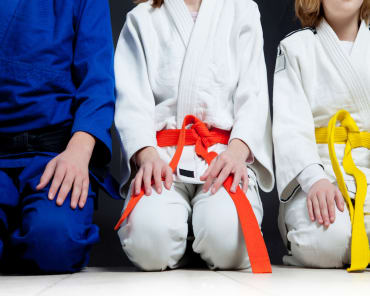Brazilian Jiu-Jitsu (BJJ) is a challenging and rewarding martial art that requires dedication, patience, and consistent practice. For many practitioners, the journey is a long one, filled with ups and downs, plateaus, and breakthroughs. To make the most of your training and stay motivated, it’s essential to set clear, attainable goals that give you a sense of direction and purpose on the mat. Whether you’re a white belt just starting out or a seasoned practitioner looking to refine your skills, having specific goals can help you track your progress and continue growing over time. In this blog, we’ll explore how to set effective goals in Jiu-Jitsu and ensure that you’re rolling with purpose in every class.
1. Start with Small, Attainable Goals
When beginning your Jiu-Jitsu journey, it’s tempting to set big goals like “earn my black belt” or “win a major tournament.” While these long-term aspirations are important, focusing on smaller, more immediate goals will help you stay motivated and measure your progress more effectively. For example, if you’re a white belt, a small goal could be to master a specific technique, such as executing a clean armbar from guard. Breaking down the journey into manageable milestones will prevent you from feeling overwhelmed and help you celebrate the small victories along the way.
Tips for small goals:
- Pick one or two techniques to focus on each week. For instance, if you’ve been struggling with guard retention, set a goal to improve your ability to hold guard during rolls.
- Track your progress by keeping a journal where you record your successes and areas for improvement after each class.
- Celebrate incremental wins. Did you finally pull off a sweep you’ve been drilling? Acknowledge it as progress!
By achieving small, focused goals, you build the foundation for tackling larger, more ambitious ones down the road.
2. Be Specific with Your Goals
The key to setting effective goals is specificity. Vague goals like “get better at Jiu-Jitsu” aren’t actionable and can leave you feeling directionless. Instead, break down exactly what you want to achieve and how you’re going to get there. For example, instead of setting a goal like “improve my guard,” a more specific goal would be “improve my spider guard sweeps by drilling them for 20 minutes after each class and using them during live rolls.”
Being specific helps you focus on measurable outcomes and gives you a clear sense of what success looks like. Whether it’s mastering a technique, increasing your stamina, or improving your mental game, specificity will guide your training sessions.
Examples of specific goals:
- “Successfully execute five triangle chokes during sparring this month.”
- “Use fewer strength-based moves and rely more on technique during sparring.”
- “Attend three open mats per month to practice rolling with different partners.”
3. Set Measurable and Time-Bound Goals
Setting measurable and time-bound goals is essential to track your progress and stay accountable. Adding a time frame to your goals creates a sense of urgency and ensures that you’re working consistently toward achieving them. Rather than saying “I want to improve my cardio,” set a measurable goal such as “I want to increase my rolling endurance by completing five consecutive rolls without stopping within the next three months.”
Incorporating time-based checkpoints into your goals gives you a clearer roadmap. It allows you to regularly assess whether you’re moving in the right direction or if adjustments need to be made to your training approach.
Examples of time-bound goals:
- “I will drill leg locks for 15 minutes after each class for the next six weeks.”
- “In two months, I want to roll without gassing out in a five-minute round.”
- “By the end of the year, I will compete in at least two local tournaments.”
Measurable goals provide a built-in feedback loop that helps you recognize your strengths and areas for improvement.
4. Focus on Process-Oriented Goals
In Jiu-Jitsu, it’s important to distinguish between outcome goals and process-oriented goals. Outcome goals focus on the results, such as winning a tournament or getting promoted to the next belt. While these goals are exciting, they can sometimes lead to frustration if you don’t achieve them as quickly as you’d like. On the other hand, process-oriented goals focus on the effort and habits required to achieve your desired outcomes.
By focusing on the process—what you can control in each training session—you’ll be more consistent and less discouraged by setbacks. A process-oriented goal could be something like “improve my mobility by dedicating 15 minutes to stretching before class” or “get comfortable with sparring by rolling with at least one higher belt during every open mat.” These goals allow you to stay present and engaged in each step of your Jiu-Jitsu journey.
Examples of process-oriented goals:
- “I will attend three classes per week, regardless of how I feel about my progress.”
- “Spend 10 minutes drilling takedowns before every class for the next month.”
- “Commit to journaling after every class to reflect on what I learned and areas for improvement.”
Process-oriented goals help you develop the discipline needed to progress over time.
5. Adapt and Adjust Your Goals as You Progress
As you move through the ranks and develop new skills, your goals should evolve. What was once challenging may become easier over time, so it’s important to continually reassess your goals and adapt them to reflect your current level of skill and understanding. For instance, if your original goal was to simply survive during sparring, as you get better, you can shift to more specific goals like successfully applying a certain submission or improving your transitions between positions.
Stay flexible with your goals, and don’t be afraid to change them based on your needs and progress. Jiu-Jitsu is a long-term journey, and what works for you as a white belt will likely change as you progress to blue, purple, and beyond.
Conclusion
Setting goals in Jiu-Jitsu is a vital part of your growth as a practitioner. Clear, attainable goals not only give you purpose but also keep you motivated and focused throughout your journey. Whether you’re working on mastering a new technique, improving your fitness, or building mental resilience, specific, process-oriented, and measurable goals will help you stay on track and consistently improve. Remember to celebrate the small victories along the way and always be willing to adapt your goals as you grow. By rolling with purpose, you’ll find that every class, drill, and sparring session brings you closer to becoming the best version of yourself on the mat.






